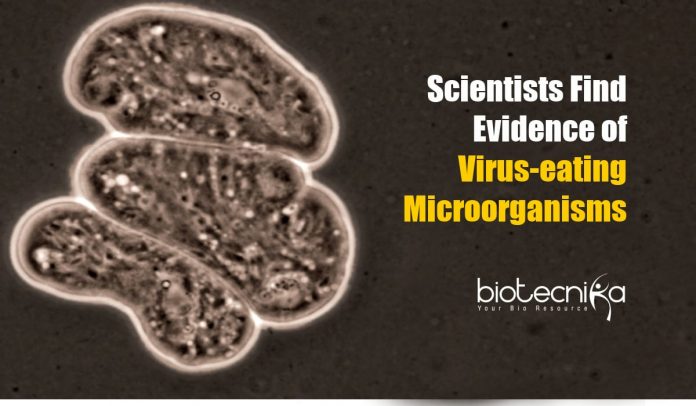Evidence of Virus-eating Microorganisms Found By Scientists
The first convincing proof of two ecologically important groups of marine microorganisms could be eating virus has been found by scientists. They found evidence of virus-eating microorganisms where these microorganisms catch their “prey” and engulf them. The present main perspectives of the role of both viruses and these groups of protists, single-celled organisms in the marine food webs are contradicted with the information found in this study, reported in Frontiers in Microbiology journal.
The Single Cell Genomics Center’s Director at Bigelow Laboratory for Ocean Sciences in the US, also the corresponding author of the study, Ramunas Stepanauskas said, “Our information provides compelling evidence that the microorganisms are consuming viruses rather than bacteria as the data showed that many protist cells contain diverse DNA of non-infectious viruses but not bacteria.”
According to scientists, “viral shunt”, where viruses-infected microbes shed a significantly small part of their chemicals back to the pool of dissolved organic matter, is the predominant model of the role of viruses in the marine ecosystem. Nonetheless, this study shows a connection in the marine microbial food web which may account for a sink of viral particles in the ocean, might complement the
viral shunt.In July 2009, the US’s Northwestern Atlantic surface seawater from the Gulf of Maine, and in July 2016 and January, the surface seawater from the Mediterranean off Catalonia, Spain were sampled by Stepanauskas and his team in the research. From around 1,698 individual protists in the water, they sequenced the total DNA by using modern single-cell genomics tools. Through this, they discovered proof of protists having associated DNA or without it. They described that the associated DNA could be from ingested prey, symbiotic organisms, or bacteria, or viruses sticking to the exterior of the protists. The researchers claimed that the method does not straight-forwardly demonstrate the type of association between a protist and its associates, as it is very sensitive.
A range of protists consisting of groups called choanozoans, picozoans, cercozoans, chlorophytes, stramenopiles, and alveolates was found by the scientists. They stated that their data suggests that the protists had eaten bacteria as they noted that around 48 percent of the genome from the single-cell organisms taken from the Mediterranean and 19 percent of those from the Gulf of Maine were associated with bacterial DNA.
However, they said that viral sequences were quite common, around 1-52 virus types per protist, which makes up 35% of the Mediterranean protists’ genome and 51% of those from the Gulf of Maine. They said that many of these were from known bacteria-infecting viruses.
Yet they claimed that picozoans and choanozoans, which were present only in the Gulf of Maine sample were different, as these groups are not known properly and they do not have chloroplasts. Since the closest living relatives of fungi and animals are the choanozoans, they are of huge evolutionary interest. The researchers said that as their feeding apparatus is very small for bacteria, yet enough for viruses, their food sources were a mystery until now.
The researchers found in the present study that viral sequences from bacteria-eating viruses called phages, usually not having any bacterial DNA, were associated with each and every genome of picozoan and choanozoan. The study noted that across a huge variety of species, the same genome sequences were observed.
From the Bigelow Laboratory for Ocean Sciences, a co-author of the study, Julia Brown stated, “The viruses able to infect all the protists in which they were found is not quite likely. Viruses could possibly be a good source to a carbon-rich diet that might include carbon-rich marine colloids or cellular prey, as they are rich in nitrogen and phosphorus.”
The researchers, bases on these findings, concluded that picozoans and choanozoans possibly eat viruses regularly.
Brown said, “Upcoming studies could take into consideration if protists that take in viruses gather their viral prey’s DNA sequences within their own genomes, or take into consideration how they could be secured from infection.
Source
Evidence of Virus-eating Microorganisms Found By Scientists































Can I have the link for the paper.